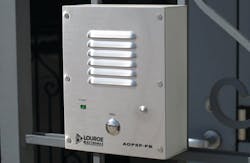Few news stories haunt us more than those of violence in schools. According to the non-profit organization Everytown for Gun Safety, there have been at least 74 school shootings in America since the Dec. 2012 Sandy Hook shooting. This statistic has highlighted the need to increase security at schools and better protect students and teachers.
With video surveillance and access control the typical backbones of a school security solution, visitor management systems are also being incorporated into their overall security plan to verify the identity of visitors before granting access.
School Security on the Rise
The 2012 Indicators of School Crime and Safety report found that between the 1999-2000 school year and the 2009-2010 school year: Controlled access to buildings during school hours increased from 75 percent to 92 percent; Controlled access to school grounds rose from 34 to 46 percent; and schools requiring faculty members to wear badges or picture IDs increased from 25 to 63 percent.
Global research firm IHS expects the market for security equipment in schools to surpass $720 million in 2014. The company also predicts the market for security systems integration in education will reach $4.9 billion by 2017, according to its 2013 Vertical Insights: Video Surveillance & Security in Education report.
Given the increased attention and focus on school security, integrators must find more solutions; however, many schools already have surveillance and access control systems in place. The challenge is to offer a cost-effective technology that adds to the existing security equipment.
Audio Enhancement
Adding a two-way audio intercom to an access control or video system is an easy way to enhance the existing system and while simultaneously differentiating an integrator’s services. Audio applications are usually compatible with existing technology, meaning installation costs are minimized; and technology does not need to be replaced or updated, which also reduces hardware costs.
Intercoms usually interface with video surveillance. The audio will serve as a security function and enable staff to speak with and screen anyone who enters or leaves the school. The intercom is also beneficial during times when a card reader malfunctions and an employee cannot enter. The employee can press the call button and speak with staff who can immediately assist.
In this instance, audio serves as a complementary function to video and access control in the solution. Together, audio and video enable security personnel or main-office staff to do a full analysis of a visitor’s appearance, gestures, tone of voice and conversation. Security officers can also speak to a suspicious person in real-time. All of these factors help staff to better verify the visitor’s identity to determine whether or not the person is a security risk.
Case in Point
Montgomery County Public Schools (MCPS)– the largest school system in Maryland, serving 151,289 students–looked to integrator Netcom Technologies Inc., to better secure the perimeter buildings of its 132 elementary schools. Netcom had previously worked with MCPS, replacing an analog CCTV system with an IP video surveillance system that required 1,600 cameras — 40-50 at each middle school and 80-100 cameras at each high school.
When it came to visitor management, MCPS didn’t have a system in place. Netcom designed a solution specific to the district’s desire to lock down doors, establish regulated access for visitors, and give staff the ability to monitor and grant access to guests.
Netcom integrated two-way audio monitoring intercoms from Louroe Electronics into the existing access control and video systems. “The product works well and functions as intended,” says Tim Roberts, RCDD, RTPM, and account manager at Netcom. “Overall, the end-user is very happy.”
To minimize network collisions and boost network connectivity, Netcom moved the access control board and main control board from the school system’s headquarters back to the individual schools. The change meant data only had to travel several hundred feet rather than several miles over the LAN. To avoid network issues, Roberts says they can install a stand-alone audio unit that directly communicates with staff at the main office, rather than connecting the intercom to the network.
Making it Work for You
Integrating an intercom in a visitor management system enhances security for the end-user while requiring minimal cost, installation, and retraining from the integrator. Here are a few recommendations from Roberts on what integrators can do to capitalize on this technology:
- Team Up With a Reputable Manufacturer: Choose a few audio and/or access control companies and learn their products and how they function. Gaining knowledge and expertise on the dealer’s solutions will help you to troubleshoot any problems down the road.
- Be An Advocate For The End-User: Discover what the end user needs and work hand-in-hand on tailoring a solution that fits them. Offer funding recommendations and suggest grants available to the end-user that can help subsidize the security project. Express the types of technologies and systems end users are interested in to the manufacturers; give manufacturers the opportunity to write programming and develop products that please the end user and earn you more business.
- Don’t Be A One-Trick Wheelhouse: Study new technologies that would be beneficial to add to your product and service offerings. As a result, you will keep up with the constantly changing demands of the security industry and remain relevant to the end-user.
Richard Brent is CEO of Louroe Electronics. To request more information about the company, please visit www.securityinfowatch.com/10214276.
About the Author
Richard Brent
Richard Brent is CEO of Louroe Electronics.
